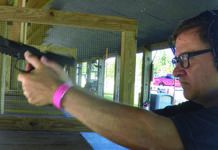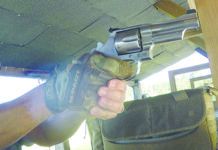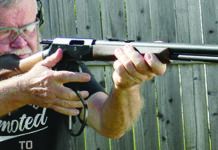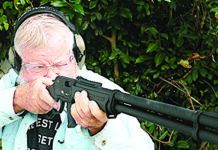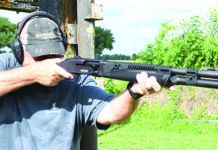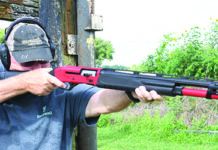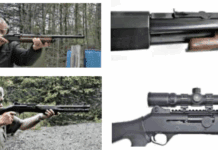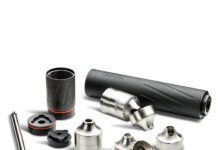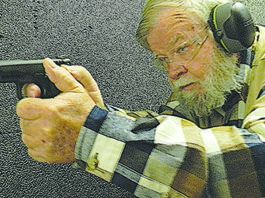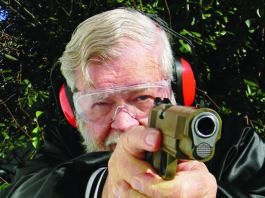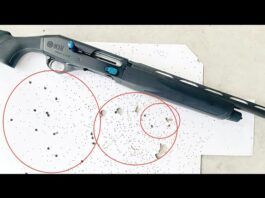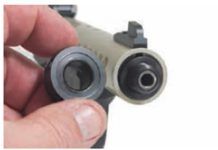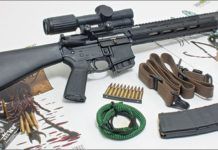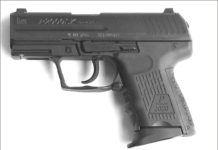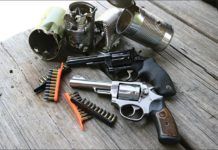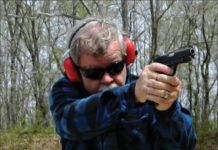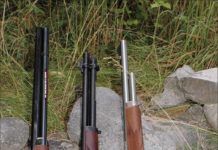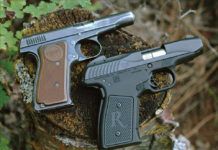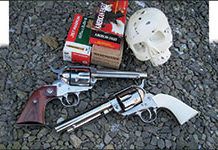(Gunsmithing the AR-15 #3) Measuring Twist Rate
If your barrel isn't marked, how can you tell what twist it has? Simple, get a cleaning rod with a swiveling handle. Fit a tight-fitting patch in it, and stuff the rod with patch down the bore. Make sure the patch can go both directions. Push in until it is ore than halfway down. Wrap a piece of masking around the rod, with the ends stuck together, forming a "flag". Attach this flag with the ends straight up, as close to the flash hider as you can. Then slowly pull the rod out, watching the flag rotate. When it comes back up to vertical, stop. Measure the distance from the flash hider to where the flag is now. That's your twist rate.
2014 Guns & Gear A List
Toward the end of each year, I survey the work R.K. Campbell, Roger Eckstine, Austin Miller, Ray Ordorica, Robert Sadowski, David Tannahill, Tracey Taylor, Rafael Urista, Ralph Winingham, and Kevin Winkle have done in Gun Tests, with an eye toward selecting guns, accessories, and ammunition the magazines testers have endorsed. From these evaluations I pick the best from a full years worth of tests and distill recommendations for readers, who often use them as shopping guides. These choices are a mixture of our original tests and other information Ive compiled during the year. After we roll high-rated test products into long-term testing, I keep tabs on how those guns do, and if the firearms and accessories continue performing well, then I have confidence including them in this wrap-up.
-Todd Woodard
Don’t Get Beat Up by High Caliber Rifles
Those of us who like big rifles have plenty to choose from, both in type of action and caliber. Some of us have found out that rifles bigger than 30 caliber are, for those prepared to learn how to control them, far more fun than those of 30 caliber and under. There are a few tricks to help you avoid being hammered by the big 'uns, and we've published a few of those tricks from time to time on these pages. For the uninitiated, begin with a heavy-enough rifle, one that has appropriate weight for the caliber. In recent tests we looked at rifles chambered for the 416 Rigby, and such a rifle could easily weigh over 10 pounds without being declared too heavy. We have seen several 416 Rigbys and even more powerful rifles that weigh as little as 8 pounds, and some even less than that. Unless you are planning to do a whole lot of carrying of a powerful rifle, it makes very little sense to have it so light.
Another easy trick is to shoot your big rifle standing up, not from the bench. Or you could construct a standing bench, so you can have the steadiness of a bench rest, but keep your body upright so you can give with the kick. Be sure the rifle has a large butt area and a properly set up recoil pad. Pads can be too soft. The rifle does not have to fire the hottest round every time you press the trigger. You can easily make your own lightly loaded rounds, and thereby learn to control the rifle by reducing its recoil, and gradually working up to full-power loads. Cast-bullet loads are ideal for this. Another trick is to put a bag of lead shot between the rifle's butt and your shoulder, a trick we used in this test. Be sure the rifle doesn't slip off the bag just as you squeeze the trigger.
For more advice and recommendations on large and small bolt-action rifles, purchase the ebook Bolt-Action Rifles & Gear, Part 1 from Gun Tests.
Varminting AR-15s: Ruger, RRA, Remington, Windham Weaponry
Coyote hunting has become a popular hunting pursuit, with new specialized rifles and equipment coming out each year. The AR-15 platform itself has become a widespread coyote-killing choice due to its handiness, accuracy, and ability to execute rapid follow-up shots. These rifles usually weigh around 7 pounds (without scope) and have a slender barrel contour. But there is more than one way to skin a coyote, as we found in a recent test.
We shot four rifles we might consider as walking-around varminters, the first being the Remington R-15 VTR Predator Carbine chambered in 223 Remington, $999, which we bought at an Academy Sporting Goods store in Houston more than a year ago (SKU #421833447, UPC 00047700601069). A recent store check didn't turn up any more of the all-black version tested here, but it is the same mechanically as the still-cataloged #60003 in the Remington line, which has an Advantage MAX-1 HD camouflage skin. This was our first look at the R-15, although we had tested the company's R-25 in the April 2009 issue.
Our next rifle marks a company's debut in these pages, the Windham Weaponry Model VEX-SS "Varmint Exterminator" R20FSSFTSKV, $1295, which was designated the WW-15 Varmint Exterminator when we began testing in May 2013.
The third was a more typical varmint rifle in the form of the Rock River Arms LAR-15 A4 Varminter AR1500X 223 Rem./5.56 NATO, $1215. This rifle was tested to provide a contrast between the more typical varmint rifle and the specialized walking varminters.
Next up was Ruger's SR-556VT Autoloading Rifle #5914, which has a 5.56 NATO chamber and lists for $1995. It joins an ever-growing list of Ruger AR-style semi-autos, including the SR-762 308 Win./7.62 NATO, which we tested in the September 2014 issue, and the others in 5.56 NATO, including the SR-556 (January 2010) and SR-556E (January 2012). After testing was complete, we learned this rifle had been recalled. More on that in a minute.
All four rifles were of the flat-top variety with Picatinny rails that allow the easy mounting of optics. To keep things consistent, we used a proven Bushnell Elite 4200 4-16x50mm scope mounted in Rock River Arms one-piece rings with a Picatinny base. For accuracy, we tested each rifle with five 5-shots groups for each of three different ammo types: TulAmmo 55-grain full metal jackets, Federal 62-grain full metal jackets, and Black Hills 77-grain moly-coated match hollowpoints. Because these rifles might be used for high-volume shooting, we fired the rifles as quickly as we could while maintaining good technique and careful sighting. We did allow time between groups for cooling. At no time did the barrels on these rifles get hot enough to prevent grasping them firmly with bare hands.
Here's how they did at the range and in the field:
S&W and H&K 9mm Compact Concealment Pistols Square Off
For more than one hundred years folks have been trying to make a service pistol fit on the hip under a covering garment. The Colt Sheriffs Model was one of the first such downsized handguns, and today practically every service pistol has a compact version. Many shooters with LE histories prefer this because they feel that a downsized service pistol still has a service-grade action and its operating principles are maintained in the more-compact form; that is, a shorter barrel and slide.
Nowadays, compacts and subcompacts for concealed carry save weight over old-generation handguns because new guns from full-size to subcompact use the same material - polymer - regardless of size. To save weight, older downsized frames had to change materials - aluminum rather than steel. Moreover, the subcompact handgun goes one further and also shortens the grip frame, so at least two dimensions shrink substantially. This is great for comfort and concealment.
The drawbacks for downsized handguns are their reliability and power, which reveals why so many popular compacts and subcompacts are chambered in the 9x19mm round. For many shooters, the 9mm is a realistic minimum for personal-defense use, and its very handy because a shooter can buy just the one caliber and have it run in full-size handguns, subcompact handguns, and carbines by pretty much anyone in the household. The 380 ACP below the 9mm is too little power for many shooters, and the 40 S&W and 45 ACP above it can prove to be a handful for smaller shooters in small guns. With proper load selection and marksmanship, the 9mm represents a reasonable level of power for a practiced shooter.
Toward that end, we selected two popular concealable handguns chambered in 9mm for this test: The Smith & Wesson Military & Police M&P9c #209004 and the H&K P2000SK #709302-A5, the first time weve tested any gun in that line. In the April 2007 issue, we shot and didnt like the M&P9c #209004. Unfortunately, that M&P Compact suffered repeated malfunctions wherein the slide would lock back with one round remaining in the magazine. Failure rate was nearly 70 percent.
In the February 2009 issue, we tried the Smith & Wesson M&P Compact 9mm No. 209304. That gun shot way high and right and not very accurately at 15 yards -- groups were around 4 inches.
However, hope springs eternal at the Gun Tests offices, so we cheerily prepped another M&P Compact 9mm and took it to the range.
To evaluate the handguns, they were fired from a solid benchrest-firing position, as we test all handguns. However, in this case the pistols were fired for groups at 15 yards rather than the 25 yards assigned for service pistols. The short sight radius and double-action trigger simply doesnt lend itself well to pinpoint accuracy.
A portion of the test that is more important to personal defense shooters is the combat firing test. This test began with man-sized silhouette targets placed at 5, 7, and 10 yards. Each pistol was drawn from concealed carry.
The Smith & Wesson was carried in a Discreet Defense Solutions inside-the-waistband holster (DiscreetDefenseSolutions.com). This holster has a good fit and comfort, and something we really needed in 98-degree heat - a sweat guard. From Mernickle Holsters
(MernickleHolsters.com) came an all-leather IWB with a strong spring-steel belt clip and a generous sweat guard. This holster was actually ordered for a Baby Eagle pistol, but it fit the H&K 2000 just fine. The pistols were belted on under a lighter covering garment, most often a sport shirt, during testing. During the combat-shooting stage, we used primarily HPRs 115-grain full metal jackets, a few 115-grain jacketed hollowpoint loads from the same maker, and Federal American Eagle 115-grain FMJs. We also were able to fire a magazine with the Winchester 127-grain SXT +P+ loads. Like many of you, we have mixed boxes left over from previous projects and this was the time to use it. The results were interesting.
Kit Guns: Ruger SP101 Rimfire Versus Used Taurus Model 94
We recently looked at new stainless steel Ruger SP101 ($699) and a used Taurus Model 94 ($300) with an eye toward finding a Bargain Hunter kit gun — generically, a knockabout handgun that was substantial enough to go into the backcountry as a plinker or small-game getter, but which didn't have to cost and arm and a leg. After the tin cans stopped jumping, we wound up with two vastly different, but very good recommendations, as kit guns. In more detail, the two contestants were a Ruger SP101 #5765 KSP-242-8 and a used Taurus Model 94, both small-frame, double-action revolvers with 4-inch barrels, adjustable sights, and high-capacity cylinders. They are chambered in 22 LR but are also compatible with 22 CB caps, 22 Shorts, 22 Longs, and 22 LR shotshells loaded with #12 shot. Besides their versatility, it's usually possible to replenish your stores of 22 cartridges pretty much anywhere that sells ammo.
In addition to simply finding the better handgun, the task here was to decide what was enough gun for this role without spending unnecessary money. With that caveat thrown in, the Taurus had a huge initial lead because it cost so much less — about $399 cheaper than list and about $235+ cheaper than prices at Cheaper Than Dirt! ($536) and Bud's Gun Shop ($540), not counting transfer fees, shipping, sales taxes and other associated costs. Our used Taurus test gun was most similar to the current production model 94B4 #2-940041, which also has a nine-shot capacity and a 4-inch barrel, a 5-inch height, and an OAL of 8.75 inches. The major difference is the new model has a full lug barrel and a price of $438. Assessing the Taurus test gun's condition, we gauged it at 90%.
To get things started, we cleaned the 94's bore thoroughly, scrubbing it with a bronze brush after letting it soak in bore cleaner. Then we tried to use a Brownells range rod (Brownells.com) to test the chamber-to-bore alignment, but the 94's bore was tight and the 22-caliber head did not fit, so we didn't force it. We thought, at worst the undersized bore would have an effect on accuracy. We hoped it would be positive. With the Ruger, we discovered all chambers were indeed aligned with the bore.
Off sandbags at 15 yards using the guns' open sights, PMC Target 40-grain roundnose ammo delivered shockingly good results in the Taurus, shooting a best-of-test 0.48-inch group on the way to an five-shot average group size of 0.68 inch, not quite half the size of the Ruger's 1.30-inch average. The Ruger did produce a marginally faster average velocity of 838 fps to the Taurus's 829 fps.
Remington Thunderbolt 40-grain roundnose ammo was a coin flip in average group accuracy, with the SP101 taking a tiny 0.96-inch edge over the Model 94 at 1 inch. The Taurus produced better velocity with this round, however, 884 fps to 862 fps.
CCI Mini-Mag 40-grain roundnoses produced groups likewise too close to call, with both handguns spitting out average group sizes of 1.20 inches, though the SP101 had the smaller best group, 0.78 inches to 1 inch for the Model 94. Velocity slightly favored the Ruger, 1005 fps to 992 fps.
All in, we found these small revolvers were well suited for plinking and small-game hunting, but we thought one offered more value.
Kimber Tactical Pro Vs. SIGs Scorpion: Two Good Carry Guns
In our latest shoot-out between 1911 handguns, we chose two of the most popular 1911s in their respective lineups. Each lists for well over twelve hundred dollars and has a legion of adherents. There are certain subjective differences in appearance that many find attractive, and design features that one shooter or the other may find more desirable. But there are differences in the handguns that will make one or the other the best choice for the individual. This was a shoot-out of the elite among 1911 handguns in some ways, and the pistols were given a thorough test for their compatibility with daily concealed carry. Our test guns were the Kimber Tactical Pro II 45 ACP, which lists for $1317. We paid $1215 for it. The SIG Sauer Carry Scorpion lists for $1213 and we paid $1180 for our test gun. The pistols are each shorter and lighter than the Government Models and are intended for 24-hour carry.
Which Is Better: 9mm Luger or 45 ACP? Answer: It Depends
When making the decision to purchase a new handgun, the question of which cartridge it will fire is the first to come up. Readers of Gun Tests are undoubtedly aware of the debate that has raged for a century about which cartridge is better between the 9mm Luger and the 45 ACP. A surface inspection of the question yields some clues such as the tendency of 9mm Luger handguns to hold more ammunition (sometimes double the magazine capacity of a 45 ACP) and 45 ACP handguns to recoil more strongly than the 9mm. The truth is that neither handgun is better in all areas, but I will use some uncommonly seen metrics derived from my slow motion videography to better explain the issue. As a disclaimer, my favorite handgun was a 45 ACP (which I sold, like many people do at one point with their favorite gun), but my carry gun is now a 9mm Luger. I sold the 45 ACP so that I wouldn't fret every morning over which gun to carry.
Three Lever-Action 45-70s: Winchester, Henry and Marlin
Up for testing this month are three 45-70 lever-action rifles. Two, by Marlin and Henry, are made in the U.S. and are fairly handy carbine-length firearms. The third is a huge, heavy, octagonal-barrel copy of the original 1886 Winchester, bearing Winchester's name but made by Miroku in Japan. The Henry and Marlin have dull finishes. The Marlin is matte stainless steel and the Henry, blued steel. The Winchester has a glossy blued finish that we thought was superb. The two carbines have appropriately padded buttstocks, but the classy-looking Winchester has a hook-shaped buttplate of steel, entirely appropriate for the era and for the weight of the gun. There were some design differences we thought were mighty interesting, including an unusual safety system on the Henry, and three different types of iron sights. We tested them using their iron sights with Remington 405-grain soft points and with Winchester 300-grain jacketed hollowpoint ammo. Here is what we found.
Remington’s New R51 9mm Pistol Is Recalled
Just before WWI, John Pedersen of Remington UMC designed a pistol of 45 ACP caliber that featured an outside hammer and a delayed recoil system that drastically reduced the felt recoil. A Navy Board recommended adopting it, but the arms factories were already geared up to make the Model 1911, so this Remington 45-caliber pistol never went into production. During the war the Pedersen Device was produced. It made the bolt-action Springfield rifle into a semi-automatic one, firing a low-powered 30-caliber round. The device did not have a locked breech, but the pistol did. Pedersens mechanism locked the round in the chamber as the chamber and slide moved rearward. When the bullet left the barrel and pressure dropped, the fired case was pulled out of the chamber, ejected, and another round put in. The system worked extremely well, and Mr. Pedersen used the same design for the Remington 51 pistol after the war. After WWI Remington entered the automatic pistol market with the innovative new Model 51 pistol in 380 ACP and 32 ACP. From 1918 to 1927 (some sources say into the 1940s) Remington manufactured the Model 51 semi-automatic pistol. Remingtons new pistol apparently didnt catch on that well, though the pistols were well thought of by those who used them. Today, Remington has essentially revised the old Pedersen pistol design in the new R51. We were able to acquire both a sample of the new R51 and one of the original Model 51s in 380. We took a good look at the two pistols, shot them, and liked a lot about the R51. However, the company has recalled all of the R51 pistols, so we assessed it a failing grade pending a warranty fix of its problems.
Mossbergs New 20-Gauge Defensive Guns
Want to start a good debate among your fellow shooters? Just toss out the question: What is the best type of firearm for home defense? Youll likely get as many answers firing back at you as different people in the room, and for the most part, most of the opinions will be (at least particularly) valid.
Certainly, those among the concealed-carry contingent will advocate the same sidearm they tote in public and practice with at the range, citing the familiarity developed with the handgun of their preference --- revolver vs. semi-auto, 1911 vs. Glock, 9mm vs. 380 vs. 45 vs. you name it is a whole other argument -- and this group of avid shooters makes a great point. Modern rifle fans will definitely dig the versatility and the visual intimidation factor of an AR. Compact when outfitted with a collapsible stock or in a carbine configuration and rigged with a tactical white light or laser sights and able to feed ample rounds in an extreme defensive situation (of course, isnt any defensive situation extreme?), its hard to argue against their choice. And of course, citing the minimized likelihood of pass-through shots in the walls and shot patters that reduce the absolute necessity for the precise aim of a single projectile, scattergun fans will espouse the benefits of the shotgun as the ultimate defensive gun. To a point theyre absolute correct as well.
From that latter option, I imagine there have been more than a few non-gun owning couples that have strolled into a gun shop in search of a firearm they can use for self-defense, particularly to put the womans mind at ease when the husband may be away, only to roll home with a hard-kicking 12-gauge that after the first shooting session, will leave the woman thinking, No Way! A local gunsmith friend of mine encountered just such an elderly couple who were looking to unload their recently purchased 12-gauge for that very reason.
My buddy suggested instead of giving up their hopes for defensive peace of mind, that they try a lighter 20-gauge. The kick is minimal, the guns are typically lighter and easier for smaller stature shooters to handle, yet available loads still deliver plenty of close-range knockdown mixed with mid-range aim forgiveness. Lets be honest. Most people who are not avid shooters, but still want a gun for home defense, are not going to practice as often as they should - if more than once or twice - and are going to require a gun that is easy to operate in an unnerving situation and offer a little insurance against an unsteady aim. In fact, it might help if the gun is visually intimidating and maybe even generates a universally understood, blood-chilling sound as it is taken to battery. That alone can sometimes mitigate a situation before a shot ever even has to be fired. Enter the 20-gauge tactical pump shotgun - two new models of which hit store shelves in 2013 courtesy of North Haven CT, gunmaker Mossberg.
The 68th edition of Gun Digest not only carries detailed round-ups of all of todays firearms, ammo and optics but dozens of articles and features on all types of shooting and firearms including the defensive guns like the Mossberg 20-gauge. To read more about this gun and others like this, purchase "Gun Digest 2014, 68th Edition" from Gun Tests.
Two Shiny Six-Shooters: Ruger New Vaquero, Traditions Frontier
Single-action-revolver purists cringe at the thought of a transfer bar in a six-shooter. The fact is, classic single actions are usually five-shooters rather than six-shooters. Reason: For safety, the loading regime for a classic single action is to load a chamber, skip a chamber, and load the rest, which allows the hammer to rest on the empty chamber. Some single actions have built-in transfer bars that are raised into firing position as the trigger is pulled to the rear. When the hammer falls in this design, it hits the transfer bar, which in turn transmits energy to the firing pin. Thus, these transfer-bar revolvers can be carried fully loaded without the risk of an discharge if the revolvers are accidentally dropped on their hammers. The ability to load six rounds appeals to plinkers, hunters, and home defenders, but to a Cowboy Action Shooting competitor, the advantage is moot — only five rounds are ever loaded at a time during CAS competition.
Accordingly, we evaluated two transfer-bar designs in 38 Special/357 Magnum chamberings more broadly than as pure competition guns. They were a Traditions Frontier Series 1873 Single Action Model No. SAT73-126, $609; and a Ruger New Vaquero No. 5108, $739. Here's what our mild bunch encountered with these transfer-bar single-action revolvers.




